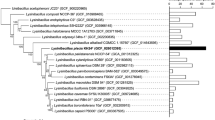Abstract
New alkaliphilic, saccharolytic, rod-shaped, gram-positive bacteria resistant to heating and drying and phylogenetically affiliated to the Bacilluslineage were isolated under strictly anaerobic conditions from sediments of the alkaline and highly mineralized Lake Magadi. Strain Z-7792 forms endospores; in strain Z-7984, endospore formation was not revealed. The strains are capable of both anaerobic growth (at the expense of fermentation of glucose and certain mono- and disaccharides with the formation of formate, ethanol, and acetate) and aerobic growth. Among polysaccharides, the strains hydrolyze starch, glycogen, and xylan. Yeast extract or methionine are required for growth. The strains are strict alkaliphiles exhibiting obligate requirement for Na+and carbonate ions, but not for Cl–ions. Growth occurs at a total mineralization as high as 3.3–3.6 M Na+, with an optimum at 1–1.7 M Na+. Strain Z-7792 is an obligate alkaliphile with a pH growth range of 8.5–11.5 and an optimum of 9.5–9.7. Strain Z-7984 grows in a pH range of 7.0–10.5 with an optimum at 8.0–9.5. Both strains are mesophiles having a growth optimum at 37–38°C. The G+C contents of the DNA of strains Z-7792 and Z-7984 are 39.2 and 41.5 mol %, respectively. These isolates of facultatively anaerobic, strictly alkaliphilic, Na+-dependent bacilli can be considered representatives of the ecological group adapted to life at drying-up shoals of soda lakes. Because of their independence of NaCl and lack of obligate dependence on sodium carbonates, the isolates are to be assigned to athalassophilic organisms. According to their physiological and phylogenetic characteristics, they taxonomically belong to group 1 of the species of bacilli with a low G+C content and occupy a position intermediate between the genera Amphibacillusand Gracilibacillus.The isolates are described as new species of Amphibacillus: A. fermentum(type strain, Z-7984T) and A. tropicus(type strain, Z-7792T).
Similar content being viewed by others
References
Horikoshi, K., Alkaliphiles: Some Applications of Their Products for Biotechnology, Microbiol. Mol. Biol. Rev., 1999, vol. 63, pp. 735–750.
Krulwich, T.A. and Guffanti, A.A., Alkalophilic Bacteria, Annu. Rev. Microbiol., 1989, vol. 43, pp. 435–463.
Weisser, J. and Trüper, H.G., Osmoregulation in a New Haloalkaliphilic Bacillus from the Wadi Natrun (Egypt), Syst. Appl. Microbiol., 1985, vol. 6, pp. 7–11.
Fritze, D., Bacillus haloalkaliphilus sp. nov., Int. J. Syst. Bacteriol., 1996, vol. 46, pp. 98–101.
Jones, B.E., Grant, W.D., Duckworth, A.W., and Owenson, G.G., Microbial Diversity of Soda Lakes, Extremophiles, 1998, vol. 2, pp. 191–200.
Tindall, B.J., Procaryotic Life in the Alkaline Saline Athalassic Environment, Halophilic Bacteria, Rodrigez-Valera, F., Ed., Boca Raton: CRC, 1988, vol. 1, pp. 31–67.
Zavarzin, G.A., Zhilina, T.N., and Kevbrin, V.V., The Alkaliphilic Microbial Community and Its Functional Diversity, Mikrobiologiya, 1999, vol. 68, pp. 579–599.
Zhilina, T.N., Zavarzin, G.A., Rainey, F.A., Kevbrin, V.V., Kostrikina, N.A., and Lysenko, A.M., Spirochaeta alkalica sp. nov., Spirochaeta africana sp. nov., and Spirochaeta asiatica sp. nov., Alkaliphilic Anaerobes from the Continental Soda Lakes in Central Asia and East African Rift, Int. J. Syst. Bacteriol., 1996, vol. 46, pp. 305–312.
Tourova, T.P., Garnova, E.S., and Zhilina, T.N., Phylogenetic Diversity of Alkaliphilic Anaerobic Saccharolytic Bacteria Isolated from Soda Lakes, Mikrobiologiya, 1999, vol. 68, pp. 701–709.
Zhilina, T.N., Garnova, E.S., and Tourova, T.P., Halonatronum saccharophilum gen. nov., sp. nov., a new Haloalkaliphilic Bacterium of the Order Haloanaerobiales Isolated from Lake Magadi, Mikrobiologiya, 2001, vol. 70, pp. 77–85.
Ash, C., Farrow, J.A.E., Wallbanks, S., and Collins, M.D., Phylogenetic Heterogeneity of the Genus Bacillus Revealed by Comparative Analysis of Small-Subunit-Ribosomal RNA Sequences, Lett. Appl. Microbiol., 1991, vol. 13, pp. 202–206.
Zhilina, T.N. and Zavarzin, G.A., Alkaliphilic Anaerobic Community at pH 10, Curr. Microbiol., 1994, vol. 29, pp. 109–112.
Hanson, R. and Phillips, J., Chemical Composition of the Bacterial Cell, Manual of Methods for General Bacteriology, Gerhardt, P. et al., Eds., Washington: Am. Soc. Microbiol., 1981. Translated under the title Metody obshchei bakteriologii, Moscow: Mir, 1984.
Lang, E. and Lang, N., Spezifische Farbreaktion zum direkten Nachweis der Ameisensaure, Fres. Z. Anal. Chem., 1972, vol. 260, no. 1, pp. 8–10.
Trüper, H.G. and Schlegel, H.G., Sulfur Metabolism in Thiorhodaceae: Quantitative Measurements on Growing Cells of Chromatium okenii, Antonie van Leeuwenhoek, 1964, vol. 30, pp. 225–238.
Pfennig, N. and Wagener, S., An Improved Method of Preparing Wet Mounts for Photomicrographs of Microorganisms, J. Microbiol. Methods, 1986, vol. 4, pp. 303–306.
Nielsen, P., Rainey, F.A., Outtrup, H., Priest, F.G., and Fritze, D., Comparative 16S rDNA Sequence Analysis of Some Alkaliphilic Bacilli and the Establishment of a Sixth rRNA Group within the Genus Bacillus, FEMS Microbiol. Lett., 1994, vol. 117, pp. 61–66.
Nielsen, P., Fritze, D., and Priest, F.G., Phenetic Diversity of Alkaliphilic Bacillus Strains: Proposal for Nine New Species, Microbiology (UK), 1995, vol. 141, pp. 1745–1761.
Duckworth, A.W., Grant, W.D., Jones, B.E., and Van Steenbergen, R., Phylogenetic Diversity of Soda Lake Alkaliphiles, FEMS Microbiol. Ecol., 1996, vol. 19, pp. 181–191.
Niimura, Y., Koh, E., Yanagida, F., Suzuki, K.-I., Komagata, K., and Kozaki, M., Amphibacillus xylanus gen. nov., sp. nov., a Facultatively Anaerobic Sporeforming Xylan-Digesting Bacterium Which Lacks Cytochrome, Quinone, and Catalase, Int. J. Syst. Bacteriol., 1990, vol. 40, pp. 297–301.
Waino, M., Tindall, B.J., Schumann, P., and Ingvorsen, K., Gracilibacillus gen. nov., with Description of Gracilibacillus halotolerans gen. nov., sp. nov.; Transfer of Bacillus dipsosauri to Gracilibacillus dipsosauri comb. nov., and Bacillus salexigens to the Genus Salibacillus gen. nov., as Salibacillus salexigens comb. nov., Int. J. Syst. Bacteriol., 1999, vol. 49, pp. 821–831.
Author information
Authors and Affiliations
Rights and permissions
About this article
Cite this article
Zhilina, T.N., Garnova, E.S., Tourova, T.P. et al. Amphibacillus fermentum sp. nov. and Amphibacillus tropicussp. nov., New Alkaliphilic, Facultatively Anaerobic, Saccharolytic Bacilli from Lake Magadi. Microbiology 70, 711–722 (2001). https://doi.org/10.1023/A:1013196017556
Issue Date:
DOI: https://doi.org/10.1023/A:1013196017556




